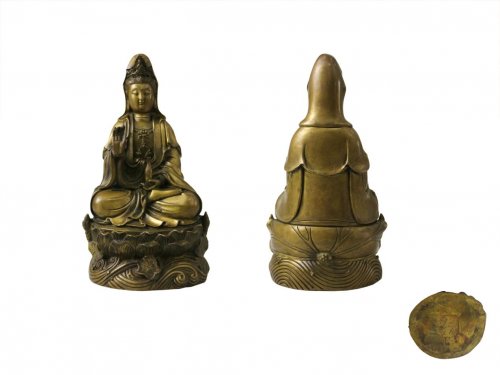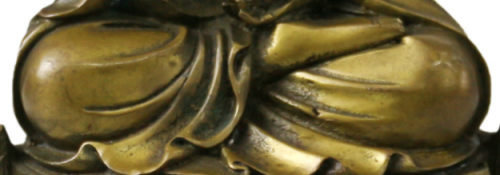
在浩瀚的中国古代佛教造像艺术长河中,清代宫廷御制佛像以其精湛的工艺、恢弘的气度与深厚的文化底蕴,成为中华文明与宗教艺术交融的璀璨结晶。这尊高24厘米、宽13厘米的“大清御制”款观音铜佛像,正是这一历史阶段的杰出代表。它不仅承载着清代鼎盛时期金属铸造技艺的巅峰成就,更以细腻的造像语言诠释了观音菩萨“大慈大悲、普度众生”的精神内核,堪称集宗教神圣性、艺术观赏性与历史研究价值于一身的传世珍品。
一、工艺巅峰:皇家血统的铸造密码

清代乾隆时期是中国古代金属工艺的集大成阶段,宫廷造办处汇聚全国顶尖工匠,以“范铸法”与“失蜡法”结合的工艺,将铜质佛像的铸造推向极致。此尊观音像以精铜为材,经多道工序锤炼:首先以蜡模塑形,外敷耐火材料形成空腔,再以高温熔铜浇铸,待冷却后打破外模,最后通过錾刻、打磨、鎏金等工序细化装饰。这种工艺的复杂性与严谨性,使得佛像表面呈现出细腻的肌理与流动的光泽,历经数百年仍保留着铜质本身的温润质感。
佛像背部“大清御制”四字楷书款识,字体端庄规整,刻工刚劲有力,是清代宫廷造像的典型标识。此类款识通常由造办处统一镌刻,需经内务府审核,确保符合皇家规范。款识的存在不仅印证了佛像的宫廷属性,更使其成为研究清代造像制度、工艺流程的实物标本。

二、造像美学:慈悲与威严的完美平衡
观音菩萨头戴五佛冠,冠顶化佛象征其“阿弥陀佛补处”的特殊地位。面相方圆丰润,双目微垂,以“蚕眉目”表现慈悲凝视众生的神态;鼻梁挺直,唇角含笑,传递出宁静祥和的宗教感染力。这种“丰颐宽额、五官精致”的造像风格,是清代宫廷佛像的典型特

征,既保留了汉地造像的温婉气质,又融入了藏传佛教造像的庄严感。

菩萨身着汉式袒右肩袈裟,衣纹呈放射状展开,层层叠叠如“曹衣出水”,既符合人体解剖结构,又通过线条的疏密变化营造出动态美感。胸前璎珞串珠雕刻精细,每一粒宝珠均以圆雕技法呈现,边缘以阴线勾勒装饰纹样,华贵而不失雅致。结跏趺坐于束腰仰覆莲座之上,莲瓣扁平规整,底沿外撇,具清代莲座的时代特征。

三、文化密码:多元交融的宗教语言
此尊观音像的造像仪轨严格遵循《造像量度经》规范,同时吸收了汉藏佛教艺术的精华。菩萨右手持净瓶,左手托杨柳枝,这一经典组合源于《妙法莲华经·观世音菩萨普门品》,象征“洒净人间、解除疾苦”的慈悲愿力。其自在坐姿(右腿支起、左腿下垂)则体现了观音“三十三化身”中的自在观音形象,寓意“随缘应化、普度众生”。

在细节装饰上,佛像融入了藏传佛教元素:五佛冠的造型、璎珞的串珠样式以及莲座的宝相花纹,均带有浓郁的藏式风格。这种汉藏艺术的融合,正是乾隆时期“兴黄教以安蒙藏”政治策略的体现,反映了清代宫廷通过宗教艺术维系民族团结的文化智慧。
四、历史见证:盛世气象的宗教投射
乾隆皇帝在位六十年,对佛教的推崇达到清代高峰。他不仅下令翻译藏文大藏经,还在宫廷中设立“中正殿”等佛教机构,征召蒙藏工匠参与造像制作。此尊观音像正是这一历史背景的产物,其造像风格既延续了明代宫廷造像的典雅,又通过繁复的装饰与精湛的工艺,彰显出“康乾盛世”的恢弘气度。
作为宫廷御制佛像,它不仅是宗教信仰的载体,更是皇权与神权结合的象征。乾隆皇帝通过大规模造像活动,宣示“天子奉佛”的政治理念,同时以精美的艺术作品传递对子民的庇佑之心。这种双重属性,使得此类佛像在历史研究中具有独特价值。
结语:跨越时空的精神对话
这尊“大清御制”款观音铜佛像,以其24厘米的身躯承载着厚重的历史与艺术。从铸造工艺的巅峰到造像美学的典范,从文化交融的见证到盛世气象的投射,它不仅是一件宗教艺术品,更是一部立体的清代文化史。当我们凝视观音低垂的双目,仿佛能穿越时空,感受到那个时代工匠的虔诚、帝王的意志与信众的祈愿。这尊佛像的存在,正是中华文明“以艺载道、以像传神”精神的永恒写照。
The Qing Dynasty Imperial Style Guanyin Bronze Buddha Statue: A Religious Art Treasure of Exquisite Craftsmanship in the Prosperous Era
In the vast river of ancient Chinese Buddhist sculpture art, the imperial Buddha statues of the Qing Dynasty, with their exquisite craftsmanship, grandeur, and profound cultural heritage, have become a brilliant crystallization of the integration of Chinese civilization and religious art. This 24 centimeter high and 13 centimeter wide "Qing Dynasty Imperial Made" Guanyin bronze Buddha statue is an outstanding representative of this historical stage. It not only carries the peak achievements of metal casting techniques during the heyday of the Qing Dynasty, but also interprets the spiritual core of Guanyin Bodhisattva's "great compassion and universal salvation" with delicate sculptural language. It can be regarded as a timeless treasure that combines religious sacredness, artistic appreciation, and historical research value.
1、 The pinnacle of craftsmanship: the casting code of royal bloodline
The Qianlong period of the Qing Dynasty was the culmination stage of ancient Chinese metal craftsmanship. The Imperial Palace Construction Office gathered top craftsmen from all over the country, using a combination of the "Fan Casting Method" and the "Lost Wax Method" to push the casting of copper Buddha statues to the extreme. This statue of Guanyin is made of refined copper and undergoes multiple processes of tempering: first, it is shaped with wax molds and coated with refractory materials to form a cavity, then cast with high-temperature molten copper, and after cooling, the outer mold is broken. Finally, the decoration is refined through processes such as chiseling, polishing, and gilding. The complexity and rigor of this craftsmanship result in a delicate texture and flowing luster on the surface of the Buddha statue, which has retained the warm texture of copper after hundreds of years.
The back of the Buddha statue is inscribed with the four characters "Made by the Qing Dynasty" in regular script. The font is dignified and neat, and the carving is vigorous and powerful. It is a typical symbol of Qing Dynasty palace statues. This type of inscription is usually uniformly engraved by the manufacturing office and needs to be reviewed by the Ministry of Internal Affairs to ensure compliance with royal regulations. The existence of the inscription not only confirms the imperial attributes of the Buddha statue, but also makes it a physical specimen for studying the Qing Dynasty's statue making system and process.
2、 Sculpture Aesthetics: The Perfect Balance of Compassion and Authority
Guanyin Bodhisattva wears a crown of five Buddhas on her head, which symbolizes her special status as a "Amitabha Buddha". The face is round and plump, with slightly drooping eyes, expressing a compassionate gaze towards sentient beings with "silkworm eyebrows and eyes"; The bridge of the nose is straight, and the corners of the lips are smiling, conveying a peaceful and peaceful religious appeal. This style of statue making, characterized by a broad forehead and delicate facial features, is a typical feature of Qing Dynasty palace Buddha statues. It retains the gentle temperament of Han Dynasty statues while incorporating the solemnity of Tibetan Buddhist statues.
The bodhisattva is dressed in a Han style robe with a right shoulder exposed, and the patterns on the robe radiate outwards, layer by layer like "Cao clothing flowing out of water". This not only conforms to the anatomical structure of the human body, but also creates a dynamic beauty through changes in the density of the lines. The chest is intricately carved with beaded ornaments, and each bead is presented using round carving techniques, with decorative patterns outlined by Yin lines at the edges, exuding both luxury and elegance. Jiexie sits on top of the lotus throne with a waist cinched and tilted back, with flat and regular lotus petals and an outward sloping base, exhibiting the characteristics of the Qing Dynasty lotus throne era.
3、 Cultural Code: Diversified and Blended Religious Language
The ritual of this statue of Avalokitesvara strictly follows the specifications of the Sutra of Measurement for Statues, and absorbs the essence of Chinese and Tibetan Buddhist art. The Bodhisattva holds a purification bottle in his right hand and a willow branch in his left hand. This classic combination originates from the Lotus Sutra of the Marvelous Dharma, the Universal Door of Avalokitesvara Bodhisattva, symbolizing the compassionate vow to "purify the world and relieve suffering". Its comfortable sitting posture (with the right leg propped up and the left leg hanging down) reflects the image of the carefree Guanyin in the "Thirty Three incarnations" of Guanyin, symbolizing "adapting to fate and saving all sentient beings".
In terms of detail decoration, the Buddha statue incorporates elements of Tibetan Buddhism: the shape of the five Buddha crowns, the beaded style of the pendants, and the precious pattern of the lotus throne, all of which have a strong Tibetan style. This fusion of Han and Tibetan art is a reflection of the political strategy of "promoting Huangjiao to pacify Mongolia and Tibet" during the Qianlong period, and reflects the cultural wisdom of the Qing court in maintaining national unity through religious art.
4、 Historical Witness: Religious Projection of Prosperous Era Atmosphere
Emperor Qianlong reigned for sixty years, and his admiration for Buddhism reached its peak in the Qing Dynasty. He not only ordered the translation of the Tibetan Tripitaka, but also established Buddhist institutions such as the "Zhongzheng Hall" in the palace and recruited Mongolian and Tibetan craftsmen to participate in the production of statues. This statue of Guanyin is a product of this historical background, and its sculptural style not only continues the elegance of Ming Dynasty palace statues, but also showcases the grandeur of the "Kangxi Qianlong prosperous era" through complex decoration and exquisite craftsmanship.
As a royal Buddha statue, it is not only a carrier of religious belief, but also a symbol of the combination of imperial and divine power. Emperor Qianlong declared the political concept of "the emperor worships Buddha" through large-scale statue making activities, while conveying his heart of protection for the people through exquisite artistic works. This dual attribute gives this type of Buddha statue unique value in historical research.
Conclusion: A Spiritual Dialogue Across Time and Space
This "Qing Dynasty Imperial Made" Guanyin bronze Buddha statue carries a heavy history and art with its 24 centimeter body. From the pinnacle of casting techniques to the epitome of sculptural aesthetics, from the witness of cultural integration to the projection of prosperous times, it is not only a religious artwork, but also a three-dimensional cultural history of the Qing Dynasty. When we gaze at Guanyin's lowered eyes, it seems like we can travel through time and feel the piety of craftsmen, the will of emperors, and the prayers of believers in that era. The existence of this Buddha statue is an eternal portrayal of the spirit of Chinese civilization, which is to convey the message through art and the spirit through images.

